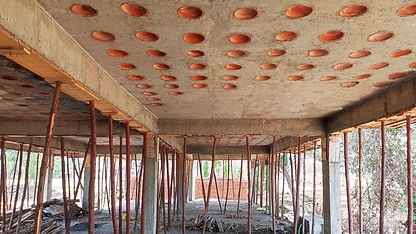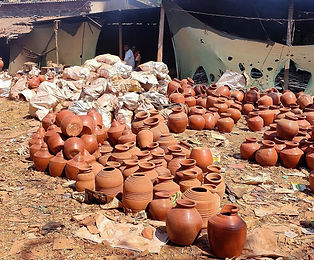Filler slab
What is filler slab:
Originally conceived by the master Architect Laurie Baker, Filler Slab is an alternative technique to conventional slab to reduce the concrete consumption, effectively making the structural system cost-efficient.


Flood affected Tribal School, Maharashtra - Visualization and Actual implementation on site
In a conventional RCC slab, the top is under compression whereas the bottom is under tension. Due to the presence of reinforcement in concrete at the bottom, some amount of vestigial concrete in the bottom, within the reinforcement grid can be partly replaced by lightweight filler materials without compromising the slab’s structural stability. Inserting earthen disks is the most common technique of filler slab. One can alternatively use mangalore tiles, bricks, coconut shells or other materials with lower embodied energy than concrete.



Filler slabs with- Discs, Mangalore tiles, Bricks, Coconut shells

How to do it:
This technique of achieving cost-effectiveness needs to be encouraged by structural engineers, supplemented by appropriate calculations from their end. Introducing earthen disks in a slab and then increasing the overall thickness of the slab would defeat the whole purpose of doing a cost-effective filler slab. It's important to cross check the percentage of concrete reduction with adequate mathematical calculations as the volume of filler material would play a significant role in concrete reductions. Deeper, wider with closely spaced earthen disks is one of the most effective ways of doing filler slab. We can reduce the concrete quantity by about 12-15% if the filler slab is designed and executed effectively.


Earthen disks- Source locally:
The overall cost of investing in earthenware needs to be much lower than that of the concrete volume intended to be reduced. Hence, earthenware should be sourced locally through a neighborhood potter to avoid transportation costs. Disks with a rim ensure better fixing to the slab shuttering using cement mortar. The roughened scratched backside of a disk ensures better grip in concrete.



.jpeg)
Studio explorations:
unTAG has always given a preference to employ local contractors / masons for making projects cost effective, also generating local employment. However, very few contractors are equipped with knowledge and expertise of practicing alternative techniques of construction. Hence,firstly educating and later hands-on training of these local contractors becomes crucial. As studio explorations, we have made an in-house miniature model of a filler slab with earthen diyas. This model conveys the intent of a filler slab very well to the site masons.




Site training:
As a part of on-site training, we firstly get a chalk marking done precisely on slab shuttering. We then explain to the contractor how to precisely insert tightly placed pots in the grid of reinforcement.
.jpg)


Site precautions:
In some cases, pots can be fixed first and then reinforcement can be tied OR the reinforcement can be done first and then pots can be inserted. In both cases workers should not step on the pots while working. The disks ideally should be properly fixed in their position using cement mortar, with adequate curing, to avoid them getting displaced during concrete pouring. This fixity also prevents cement slurry from entering the underbelly of disks which could decolor them. De-shuttering needs to be done carefully to preserve the disk rims. Further, These rims can be wrapped with paper tape before plastering or painting the slab surface.
.jpg)


Inference:
FInally, we feel filler slab technology should be practiced with an intent to save concrete and not just as an aesthetic value addition. Not following the correct techniques would only add to the overall cost, and would defy the whole purpose of Baker’s original intent of bringing cost-effectiveness in architecture.


Team members- Nikita Patil, Yash Prabhu, Kavya Shah, Sakshi Maeen, Manthan Mulik, Gauri Satam, Tejesh Patil
Sketches- Sakshi Waman





